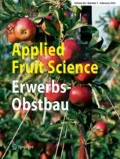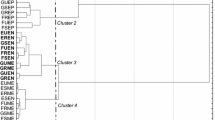Abstract
Total and specific phenolic compounds and antioxidant capacity were quantified over two seasons in flowers, leaves, fruitlets, and ripe fruit at harvest of the apple cultivars ‘Brookfield’, ‘Granny Smith’ and ‘Fuji’, as well the crabapple cultivars ‘Hillary’ and ‘Manchurian’. The results showed that leaves had the highest phenol concentrations and antioxidant capacity. Phenolic and antioxidant content was progressively lower from flowers, fruitlets, and ripe harvested fruit. There were high concentrations of phloridzin in flowers and leaves, while concentrations were lower in fruitlets, peel, and entire fruit at harvest. The phenolic compound with the highest concentration in peel was quercetin glycoside, while in the entire fruit it was flavanols. The studied crabapple cultivars did not present differences between them in phenolic compounds and antioxidant capacity.






Similar content being viewed by others
References
Akiyama H, Sato Y, Watanabe T, Nagaoka M, Yoshioka Y, Shoji T, Kanda T, Yamada K, Totsuka M, Teshima R, Sawada J, Goda Y, Maitani T (2005) Dietary unripe apple polyphenol inhibits the development of food allergies in murine models. Febs Lett 579:4485–4491. https://doi.org/10.1016/j.febslet.2005.07.019
Barreira JCM, Ferreira ICFR, Oliveira BMPP, Pereira JA (2008) Antioxidant activities of the extracts from chestnut flower, leaf, skins and fruit. Food Chem 107:1106–1113. https://doi.org/10.1016/j.foodchem.2007.09.030
Bernier G, Kinet J, Sachs R (1984) The initiation of flowers. The physiology of flowering, vol I. CRC Press, Boca Ratón, p 274
Buban T, Faust M (1982) Flower bud induction in apple trees: internal control and differentiation. Hortic Rev 4:174–202
Coseteng M, Lee C (1987) Changes in apple polyphenoloxidase and polyphenol concentrations in relation to degree of browning. J Food Sci 52(4):986–989. https://doi.org/10.1111/j.1365-2621.1987.tb14257.x
Cyboran S, Bonarska D, Kapusta I, Oszmiański J, Kleszczyńska H (2011) Antioxidant potentials of polyphenolic extracts from leaves of trees and fruit bushes. Curr Top Biophys 34:15–21. https://doi.org/10.2478/v10214-011-0003-4
Dixon RA, Paiva NL (1995) Stress-induced phenylpropanoid metabolism. Plant Cell 7:1085–1097
Escarpa A, González MC (1998) High-performance liquid chromatography with diode-array detection for the determination of phenolic compounds in peel and pulp from different apple varieties. J Chromatogr A 823:331–337
Faust M (1989) Physiology of temperate zone fruit trees. Wiley, New York, p 388
Gosch C, Halbwirth H, Kuhn J, Miosic S, Stich K (2009) Biosynthesis of phloridzin in apple (Malus domestica Borkh.). Plant Sci 176:223–231. https://doi.org/10.1016/j.plantsci.2008.10.011
Grochowska MJ (1963) Studies on natural growth regulators in apple trees in relation to biennial bearing. Bull Acad Pol Sci Biol 12:379–383
Hancock CR, Harlow WB, Lacey HJ (1961) The behaviour of phloridzin in the coleoptile straight-growth test. J Exp Bot 12:401–408. https://doi.org/10.1093/jxb/12.3.401
Henríquez C, Almonacid S, Chiffelle I, Valenzuela T, Araya M, Cabezas L, Simpson R, Speisky H (2010) Determination of antioxidant capacity, total phenolic content and mineral composition of different fruit tissue of five apple cultivars grown in Chile. Chil J Agric Res 70(4):523–536. https://doi.org/10.4067/S0718-58392010000400001
Hu FB (2003) Plant-based foods and prevention of cardiovascular disease: an overview. Am J Clin Nutr 78:544–551. https://doi.org/10.1093/ajcn/78.3.544S
Huang D, Ou B, Hampsch-Woodill M, Flanagan J, Deemer EK (2002) Development and validation of oxygen radical absorbance capacity assay for lipophilic antioxidants using randomly methylated beta-cyclodextrin as the solubility enhancer. J Agric Food Chem 50(7):1815–1821. https://doi.org/10.1021/jf0113732
Ikram EHK, Eng KH, Jalil AMM, Ismail A, Idris S, Azlan A (2009) Antioxidant capacity and total phenolic content of Malaysian underutilized fruits. J Food Compost Anal 22(5):388–393. https://doi.org/10.1016/j.jfca.2009.04.001
Jakopic J, Zupan A, Schmitzer V, Stampar F, Veberic R (2016) Sugar and phenolics level dependent on the position of apple fruitlet in the cluster. Sci Hortic 201:362–369. https://doi.org/10.1016/j.scienta.2016.02.011
Kaisoon O, Siriamornpun S, Weerapreeyakul N, Meesoc N (2011) Phenolic compounds and antioxidant activities of edible flowers from Thailand. J Funct Foods 3:88–99. https://doi.org/10.1016/j.jff.2011.03.002
Kaur G, Alamb MS, Jabbar Z, Javed K, Athar M (2006) Evaluation of antioxidant activity of Cassia siamea flowers. J Ethnopharmacol 108:340–348. https://doi.org/10.1016/j.jep.2006.05.021
Kuti JO, Konuru HB (2004) Antioxidant capacity and phenolic content in leaf extracts of tree spinach (Cnidoscolus spp.). J Agric Food Chem 52(1):117–121. https://doi.org/10.1021/jf030246y
Li N, Junling S, Wang K (2014) Profile and antioxidant activity of phenolic extracts from 10 crabapples (Malus wild species). J Agric Food Chem 62:574–581. https://doi.org/10.1021/jf404542d
Liaudanskas M, Viskelis P, Raudonis R, Kviklys D, Uselis N, Janulis V (2014) Phenolic composition and antioxidant activity of Malus domestica leaves. Sci World J. https://doi.org/10.1155/2014/306217
Mayr U, Treutter D, Santosbuelga C, Bauer H, Feucht W (1995) Developmental changes in the phenol concentrations of Golden Delicious apple fruits and leaves. Phytochemistry 38:1151–1155. https://doi.org/10.1016/0031-9422(94)00760-Q
Oktay M, Guloin I, Kufrevioglu OI (2003) Determination of in vitro antioxidant activity of fennel (Foeniculum vulgare) seed extracts. LWT Food Sci Technol 36:263–271. https://doi.org/10.1016/S0023-6438(02)00226-8
Prior RL, Hoang H, Gu L, Wu X, Bacchiocca M, Howard L, Hampsch-Woodill M, Huang D, Ou B, Jacob R (2006) Assays for hydrophilic and lipophilic antioxidant capacity (oxygen radical absorbance capacity (ORAC (FL))) of plasma and other biological and food samples. J Agric Food Chem 51(11):3273–3279. https://doi.org/10.1021/jf0262256
Rice E (1984) Allelopathy, 2nd edn. Academic Press, , p 422
Shallcross L (2011) Crabapples. FNH, vol 00109. Extension Faculty, Health, Home and Family Development. Cooperative Extension Service University of Alaska, Fairbanks, pp 1–4
Shi J, Gong J, Liu J, Wu X, Zhang Y (2008) Antioxidant capacity of extract from edible flowers of Prunus mume in China and its active compounds. LWT Food Sci Technol 42:477–482. https://doi.org/10.1016/j.lwt.2008.09.008
Teleszko M, Wojdyło A (2015) Comparison of phenolic compounds and antioxidant potential between selected edible fruits and their leaves. J Funct Foods 14:736–746. https://doi.org/10.1016/j.jff.2015.02.041
Treutter D (2001) Biosynthesis of phenolic compounds and its regulation in apple. Plant Growth Regul 34:71–89
Van Der Sluis AA, Dekker M, Skrede G, Jongen WMF (2002) Activity and concentration of polyphenolic antioxidants in apple juice. I. Effect of existing production methods. J Agric Food Chem 50:7211–7219. https://doi.org/10.1021/jf020115h
Yanishlieva-Maslarova NV (2001) Inhibiting oxidation. In: Pokorny J, Yanish N, Gordon MH (eds) Antioxidant in food: practical applications. Woodhead, Cambridge, pp 22–70
Younwei Z, Jinlian Z, Yonghong PA (2008) A comparative study on the free radical scavenging activities of some fresh flowers in southern China. LWT Food Sci Technol 41:1586–1591. https://doi.org/10.1016/j.lwt.2007.10.010
Yuri J, Maldonado F, Razmilic I, Neira A, Quilodran A, Palomo I (2012) Concentrations of total phenols and antioxidant activity in apple do not differ between conventional and organic orchard management. J Food Agric Environ 10(2):207–216
Yuri JA, Quilodrán A, Motomura Y, Palomo I (2009) Antioxidant activity and total phenolics concentration in apple peel and flesh is determined by cultivar and agroclimatic growing regions in Chile. J Food Agric Environ 7(3–4):513–517
Zhang YZ, Li PM, Cheng LL (2010) Developmental changes of carbohydrates, organic acids, amino acids, and phenolic compounds in ‘Honeycrisp’ apple flesh. Food Chem 123:1013–1018. https://doi.org/10.1016/j.foodchem.2010.05.053
Zheng HZ, Kim YI, Chung SK (2012) A profile of physicochemical antioxidant changes during fruit growth for the utilisation of unripe apples. Food Chem 131:106–110. https://doi.org/10.1016/j.foodchem.2011.08.038
Acknowledgements
This research is part of the Project IT13I20048 supported by ‘Fondo de Fomento al Desarrollo Científico y Tecnológico’ (FONDEF), Chile.
Author information
Authors and Affiliations
Corresponding author
Ethics declarations
Conflict of interest
J.A. Yuri, A. Neira, M. Fuentes, B. Sáez and I. Razmilic declare that they have no competing interests.
Rights and permissions
About this article
Cite this article
Yuri, J.A., Neira, A., Fuentes, M. et al. Have the Flowers, Fruitlets, Ripe Fruit and Leaves of Apples Cultivars Similar Compositions of Phenolic and Antioxidant Capacity?. Erwerbs-Obstbau 64, 201–209 (2022). https://doi.org/10.1007/s10341-022-00638-1
Received:
Accepted:
Published:
Issue Date:
DOI: https://doi.org/10.1007/s10341-022-00638-1




